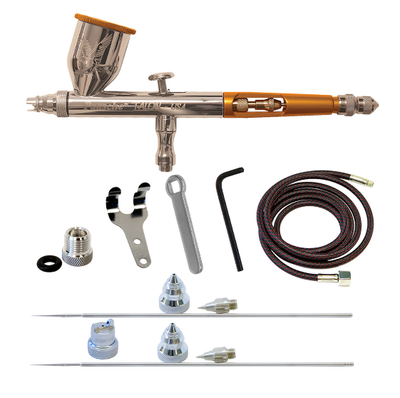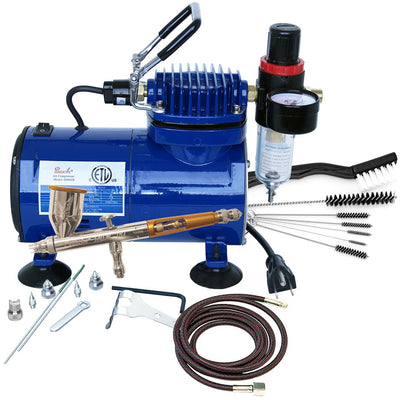How to Choose an Airbrush – The Complete Guide
An airbrush is a great tool for detailed spraying, from spraying model vehicles, to t shirts, to cake decorations, and more airbrushes have a variety of uses. In order to choose an airbrush that will be best for your project needs, you typically want to consider a few main factors. These include whether your airbrush will be gravity or siphon fed, the tip sizes included with your airbrush, internal vs external mix, and single vs dual action airbrushes. We’ll dive into each of these areas further so you can choose which airbrush will be best for your needs.
Single vs Dual Action Airbrushes
The action of an airbrush refers to how the trigger functions. With a single action airbrush as you pull back the trigger, air is released from the airbrush which then atomizes the paint. In a single action airbrush, paint volume is controlled by adjusting a fluid needle to the desired point. A single action airbrush is simple to use, however, you cannot change the amount of paint being dispensed without stopping airbrushing. This makes a single action airbrush friendly for beginners and for larger patterns but with certain limitations when it comes to flexibility in the middle of airbrushing.
A dual action airbrush provides control of both air and paint volume by the pull of the trigger. When the trigger is pushed down, air is released from the airbrush, when it is pulled back paint can be released. The further back you pull the trigger the more paint you receive. A dual action airbrush provides greater control and flexibility during airbrushing, making it the most common choice for a professional or someone who values having the most flexibility. It is generally better for fine detail work as well.
Gravity vs Siphon Feed vs Side Feed Airbrushes
Gravity feed airbrushes have the cup on top of the airbrush. The benefit of a gravity feed airbrush is that it can feed paint at any given air pressure, which allows for paint to be applied at low pressures. When doing detail work with an airbrush you typically will want lower pressures to reduce overspray, so for detail work (fine lines) a gravity airbrush is often the best choice. In addition to generally being better for fine line work, a gravity brush is usually easier to clean because it has less parts relative to a siphon airbrush. The downside to a gravity airbrush is that it will not hold as much paint as a siphon airbrush.
Siphon feed airbrushes have the cup underneath the airbrush. This allows for more paint to be stored in a siphon airbrush. This makes the siphon airbrush ideal for larger airbrushing projects as you will not have to stop as often to refill the airbrush.
Side feed airbrushes seek to provide the benefits of both types of airbrushes. They can hold more volume than a gravity airbrush and operate better at low pressures than a gravity airbrush. However they are very difficult to clean and can often have leaks, this makes them less popular than gravity & siphon fed airbrushes.
Internal vs External Mix
An additional factor to consider is whether you will choose an internal or external mix airbrush. An external mix airbrush mixes the paint and air outside of the airbrush. While an internal mix airbrush mixes the paint and air inside of the airbrush. External mix airbrushes are less common because they do not produce as fine of a pattern as an internal mix airbrush and they do not atomize paint quite as well.
However, they can atomize thicker paint more effectively, making them a good option for large area coverage with thicker paints. Internal mix airbrushes tend to be more common and popular as a choice because they produce slightly better breakup and produce finer lines relative to an external mix airbrush.
Tip sizes
A final factor to consider is the tip sizes you want with your airbrush. Typical airbrush nozzles range in size from 0.2mm to 0.7 mm. In general, a larger tip size allows you to spray thicker material but can cause the line size to be bigger as well. A common choice is a 0.5 mm tip which is a good multi use tip. For best flexibility choosing an airbrush with multiple tips is ideal. For detailed work anything from a 0.5 mm and below is best while for broad coverage a 0.5mm or larger will be ideal. As a general rule, an airbrush set with multiple tips will provide the greatest flexibility for your project needs.
Final Thoughts
Choosing the best airbrush for you will depend on your experience and the projects you want to tackle. To summarize all the different information presented we can provide a few common options that will make sense. For greatest flexibility from detailed work to broad pattern projects, choose a dual action airbrush with multiple tips included. If you will do more detailed work then large areas go with a gravity feed, while if you will do large patterns more, consider a siphon feed. For ease of use, consider a single action siphon feed airbrush with multiple tips or a 0.5 tip.
Ultimately, by considering all the factors discussed, you will be able to choose an airbrush that will work best for your project needs.



